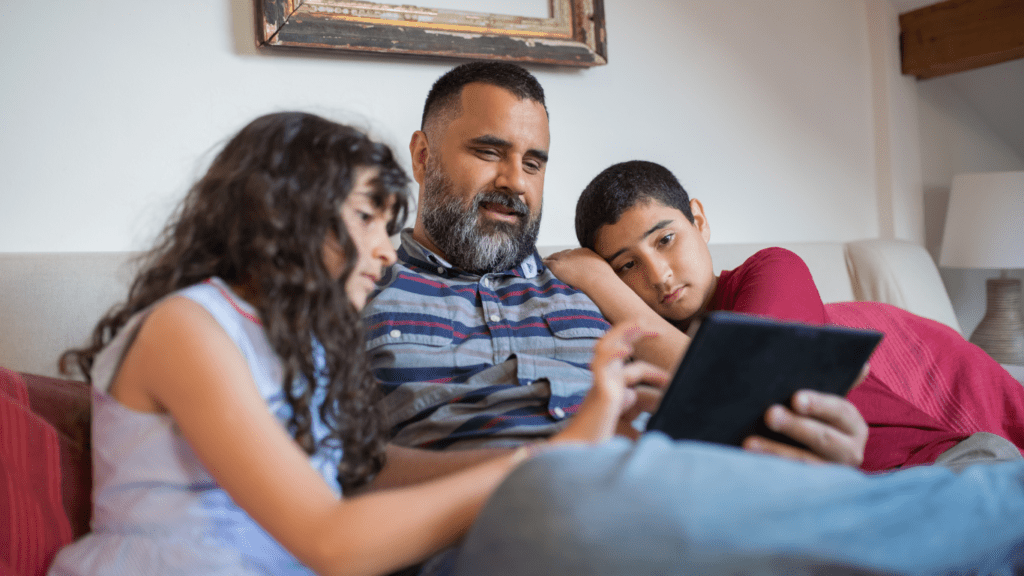Understanding Screen Time and Its Effects on Children
Screen time can heavily influence a child’s development. Knowing the impacts can help you manage your child’s gaming habits better.
The Psychology Behind Screen Attraction
Children find screens captivating due to their interactive and stimulating nature. Video games, in particular, offer immediate rewards and engaging narratives, which keep children hooked.
Dopamine release, triggered by achievements in games, can cause a pleasure-driven cycle, making it hard for children to disengage.
Health Impacts of Excessive Screen Time
Excessive screen time can lead to physical health issues. Strain on the eyes, poor posture, and sedentary habits contribute to problems like:
- eye fatigue
- neck pain
Long screen exposure can disrupt sleep patterns. The blue light emitted by screens affects the production of melatonin, a hormone that regulates sleep.
Understanding these factors can guide your approach to balancing your child’s screen time effectively.
Setting Realistic Screen Time Limits
Balancing screen time requires practical guidelines and structured limitations. I’ll provide age-appropriate recommendations and methods for creating a balanced daily schedule.
Age-Appropriate Screen Time Recommendations
Pediatricians recommend specific screen time limits based on age. For children aged 2-5, limit screen time to one hour per day of high-quality programming.
For children aged 6 and older, the recommendation is consistent screen limits that prioritize productive use and educational value.
- Ages 2-5: Up to 1 hour per day, with parents co-viewing to explain content.
- Ages 6-12: Prioritize educational content, ideally 1-1.5 hours daily beyond schoolwork.
- Teens: Encourage self-regulation and critical thinking about the content, aiming for 2 hours max.
Creating a Balanced Daily Schedule
Incorporate a variety of activities throughout the day to ensure a balanced schedule. Start with school responsibilities, include physical activities, and designate specific gaming times.
- Morning: Focus on education and physical exercise before any screen time.
- Afternoon: Include hobbies, chores, and brief gaming intervals.
- Evening: Reserve time for relaxation and offline family activities.
Using structured daily plans greatly enhances the balance between screen time and other essential activities.
Strategies for Balancing Gaming and Family Time

Balancing gaming and family time requires deliberate strategies. Parents can enhance family cohesion by being involved and encouraging diverse interests.
Involvement in Children’s Gaming
Being actively involved in children’s gaming builds trust. Learn about the games your children enjoy. Play with them to understand their interests and to spend quality time. You can even encourage creative off-screen activities inspired by gaming, such as making a video animation based on their favorite characters or storylines.
Discuss the content, rules, and goals of the games to ensure they’re appropriate and to build an open dialogue about gaming choices. Set limits together, making children part of the decision-making process.
Encouraging Other Interests and Social Activities
Fostering other interests helps balance gaming and overall development. Promote hobbies like reading, sports, and arts to engage children’s minds and bodies.
Encourage participation in social activities, such as joining clubs or community programs, to build interpersonal skills. Introducing family activities and outings offers an example of non-digital engagement.
Model and support diverse interests to ensure a well-rounded lifestyle.
The Role of Parental Controls and Tools
Balancing children’s screen time remains challenging. However, parental controls and technological tools offer effective solutions for managing gaming habits and ensuring a healthy lifestyle.
Using Technology to Manage Gaming Habits
Various parental control options can help manage children’s gaming habits.
Software such as Qustodio, Norton Family, and Bark allows parents to monitor and limit screen time, block inappropriate content, and receive activity reports.
Game consoles like Xbox and PlayStation offer built-in features to set time limits and restrict certain games based on content ratings. Using these tools consistently helps create an environment that encourages responsible gaming.
Educational Games and Apps to Consider
Utilizing educational games and apps can turn screen time into a learning opportunity. Apps like ABCmouse, Khan Academy Kids, and Duolingo offer age-appropriate educational content while engaging children in interactive learning.
Math-oriented games like Prodigy and logic-based games like ChessKid enhance problem-solving skills and cognitive development.
Integrating these educational tools into children’s gaming schedules supports academic growth along with entertainment.
h thoughtful strategies we can ensure our kids enjoy gaming without it negatively impacting their development.



